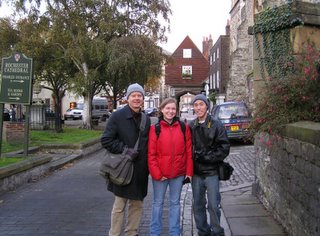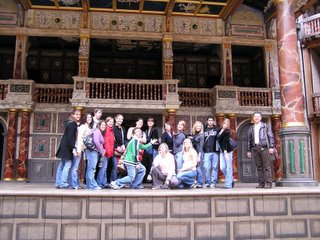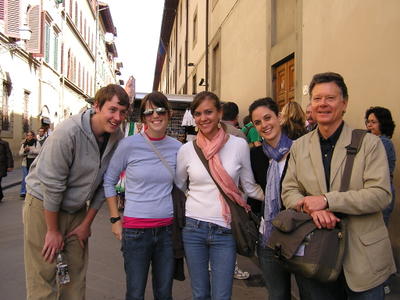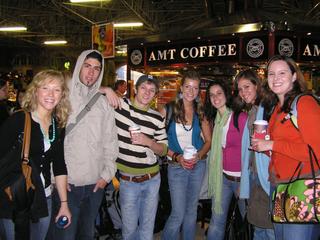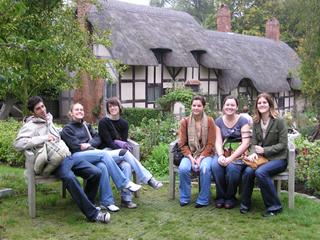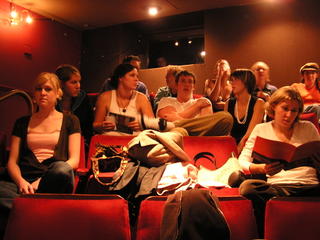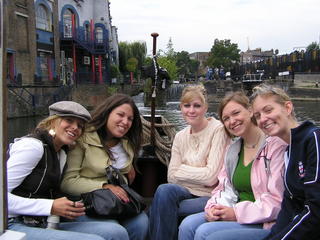
This week featured maritime-themed activities and culminated with a celebration of Guy Fawkes Day. On Wednesday, the "Age of Sail" class visited Greenwich and the
National Maritime Museum. We saw a special exhibit on “
Nelson and Napoleon” documenting the conflict between France and England at the turn of the 19th century. Part of the bicentennial commemoration of the Battle of Trafalgar, the fascinating exhibit included hundreds of items: from French
revolutionary artifacts to contemporary English
political cartoons lampooning Napoleon to the
coat Nelson wore at Trafalgar, holed in the left shoulder where the fatal musket ball tore through his epaulette. We also visited the
Queen’s House, a centerpiece of classical architecture designed by Inigo Jones, and viewed the numerous
maritime paintings there, including
Turner's epic tribute to the battle, commissioned by George IV. Despite the attractions of
Greenwich in fall, students chose to consider the observatory from here rather than trek uphill in the rain. Before returning to the Docklands Light Railway station, we admired the dry-docked
Cutty Sark, a great merchant clipper ship from the late days of sail.
On Friday, a clear and windy day, the entire group boarded the train for Portsmouth to visit the
Historic Dockyard, from which Nelson sailed to meet the French and Spanish fleets off Trafalgar in 1805. We toured his flagship,
Victory, viewed the great cabin, gundecks, magazine and hold, and, as wind hummed through the rigging, stood on the quarterdeck where Nelson fell. Centuries earlier, Henry VIII had his fleet based in Portsmouth, and during an engagement with the French in 1545, his flagship the
Mary Rose sank in the Solent. In 1982, divers retrieved much of the vessel’s hull along with numerous
Tudor artifacts. The remaining timbers of the Mary Rose, dimly lit and under a constant spray of preservative wax solution, are
on display* in a special observation hall. After viewing the
Victory and
Mary Rose and other related exhibits, we took an hour’s cruise of the
harbor. Among the sights were Portsmouth’s newly opened
Spinnaker Tower and several vessels of Britain’s modern navy, including a Harrier jet carrier,
HMS Illustrious. During the remaining free time, some students browsed the Gunwharf outlet mall, while others toured the impressive
HMS Warrior, a hybrid steam and sail battleship that dominated the seas in Queen Victoria’s day.
Saturday evening, site director Martin Upham invited us all to his charming home in Crouch End for a cup of mulled wine, followed by spectacular Bonfire Night
fireworks* and a barbeque feast. The party was a resounding success, a festive conclusion to an eventful week.
More Photos
Royal Naval College at Greenwich
Student presentation on the Mary Rose 1...2
Inside the Mary Rose observation hall
Students at HMS Victory 1...2...3
Students take in museum exhibits: hands-on knot tying and ship figureheads
Group waiting to board the cruise
Students on the cruise
Portsmouth skyline with Victory's masts
HMS Warrior's figurehead and a huge flock of starlings in the rigging
Evening falls on Portsmouth's street and harbor
Students on the train back to London 1...2
Guy Fawkes Day fireworks*
*Special thanks to Peter Chee for photos of the Mary Rose and Bonfire Night fireworks.
Up next
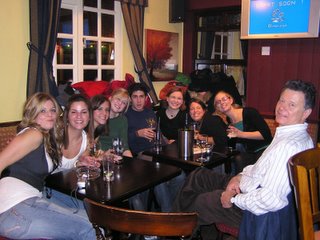 With final exams finished by Wednesday, a few students departed early, and the rest of the crew gathered at the London Centre for Thanksgiving dinner. Afterwards, students exchanged hugs and telephone numbers and, in mixed relief and wistfulness, set out to enjoy their last weekend in London. Several gathered that evening at the Manor pub in Eastcote for a karaoke fest.
With final exams finished by Wednesday, a few students departed early, and the rest of the crew gathered at the London Centre for Thanksgiving dinner. Afterwards, students exchanged hugs and telephone numbers and, in mixed relief and wistfulness, set out to enjoy their last weekend in London. Several gathered that evening at the Manor pub in Eastcote for a karaoke fest.